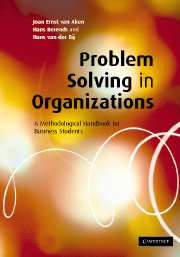Book contents
- Frontmatter
- Contents
- List of figures
- List of boxes
- Preface
- Part I Fundamentals
- Part II The problem-solving project
- 5 Intake and orientation
- 6 Theory-based diagnosis of business problems
- 7 Solution design
- 8 Change plan design and the actual change process
- 9 Evaluation, reflection and termination
- Part III On methods
- Part IV Conclusion
- References
- Index
5 - Intake and orientation
from Part II - The problem-solving project
Published online by Cambridge University Press: 04 December 2009
- Frontmatter
- Contents
- List of figures
- List of boxes
- Preface
- Part I Fundamentals
- Part II The problem-solving project
- 5 Intake and orientation
- 6 Theory-based diagnosis of business problems
- 7 Solution design
- 8 Change plan design and the actual change process
- 9 Evaluation, reflection and termination
- Part III On methods
- Part IV Conclusion
- References
- Index
Summary
General setup
The business problem-solving (BPS) project starts with an intake process and an orientation process. In terms of the regulative cycle, intake and orientation should together be regarded as the ‘problem definition’ step. In terms of a consulting project, intake should be regarded as the contracting phase. A successful intake process results in a written initial assignment. Based upon that initial assignment, work within a company begins with a relatively brief orientation phase. For a nine-month BPS project, the orientation phase should take no more than four weeks. Orientation will result in a further detailing of the technical content of the assignment, but typically not of its contractual conditions. Orientation results in a definitive project proposal, including the definitive assignment.
A typical project proposal discusses six issues:
The problem context: a brief description of the company in question and the background of the project (see section 5.4).
The problem statement: the problem statement is a crucial part of the project proposal. The problem statement is preferably accompanied by a preliminary analysis of causes and effects, as that may support the ‘naming and framing’ of the problem and the design of the project approach (see section 5.5).
The assignment: this section of the project proposal contains the deliverables that will be generated by the project (see section 5.6).
The project approach: the student should design both a conceptual and a technical approach to solve the problem (see section 5.7).
The costs of the project: the expected costs of the project should be specified as much as possible (see section 5.8)
[…]
Information
- Type
- Chapter
- Information
- Problem Solving in OrganizationsA Methodological Handbook for Business Students, pp. 41 - 62Publisher: Cambridge University PressPrint publication year: 2007
